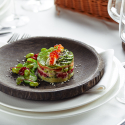Lose 8 kg in 14 Days: The Essentials of the Japanese Diet and a Nutritionist’s Menu
 Explore the benefits and drawbacks of this dietary plan.
Explore the benefits and drawbacks of this dietary plan.The Japanese diet is considered one of the healthiest in the world. We consulted an expert to understand its principles, benefits, and potential risks.
What is the Japanese Diet?
"The Japanese diet is a low-carb, high-protein eating plan that promises rapid weight loss over a short period." The Japanese are known for their longevity, largely attributed to their diet. Traditional Japanese cuisine uses simple, fresh ingredients and minimizes refined and processed foods.
This diet includes fish (both cooked and raw), seafood, soybeans, seaweed, noodles, and steamed rice. It is low in processed animal proteins, refined sugars, and fats, which are detrimental to health, especially cardiovascular health. The diet also features many pickled and fermented foods like miso, soy sauce, natto (fermented soybeans), pickled ginger, rice vinegar, and tsukemono (pickled vegetables).
Japanese people also favor green tea, particularly matcha, which is rich in antioxidants like catechins that reduce the risk of cancer, viruses, and cardiovascular diseases.
Benefits of the Japanese Diet
For those looking to shed pounds, the benefits are clear: the diet aids in significant weight loss within a short time frame. In just 14 days, one can lose an average of five to eight kilograms.
The Japanese diet also enhances digestion due to its high content of grains and fiber from vegetables, helping to combat constipation. Traditional Japanese cuisine focuses on seasonal products, maximizing the nutritional content of food. The diet is rich in fiber, calcium, magnesium, iron, potassium, and vitamins A, C, and E, which help cells repair. Omega-3 fatty acids from fish and seafood support brain, eye, and cardiovascular health.
Health Risks
Following the Japanese diet for an extended period is not recommended due to its imbalance in macronutrients (low-calorie intake) and the near absence of breakfast.
This low-calorie, high-protein menu should not be repeated more than once every six months.
Another characteristic of the Japanese diet is the initial rapid weight loss, often followed by a relapse and depression, leading to the return of the original weight plus extra kilograms. Contraindications include pregnancy or breastfeeding, chronic gastritis and ulcers, chronic kidney diseases, and cardiovascular disorders.
Diet Principles
The Japanese diet is not balanced, making it unsafe to follow for more than two weeks. Even within 14 days, the body may react negatively to reduced carbohydrate intake, causing body aches, headaches, and weakness.
If you experience these symptoms, stop the diet and consult a doctor! Proper hydration is crucial, with a recommendation to drink at least two liters of room-temperature, non-carbonated water daily.
The key to success on the Japanese diet is strict adherence to its plan. Do not mix up meals or substitute ingredients at your discretion. It’s advised to eliminate salt entirely or reduce its intake to three grams per day.
The Japanese diet may seem challenging due to the limited number of meals per day: only three instead of the healthier five or six. Mornings should start with a glass of water on an empty stomach, and dinner should be at least two hours before bed. Snacks are not allowed.
Since the 14-day Japanese diet is strict, it’s important not to start it abruptly. Prepare yourself mentally and physically by reducing fast food and sweets and cutting down portion sizes.
14-Day Japanese Diet Menu
The menu of the Japanese diet includes easily accessible ingredients available at any supermarket.
Ingredients:
Unsweetened green tea - 1 pack
Coffee beans or ground coffee - 1 pack
Chicken eggs - 20 pieces
Lean beef or ground beef - 1 kg
Fillet of sea fish - 2 kg
Chicken fillet - 1 kg
White cabbage - 2 medium heads
Extra virgin olive oil - 500 ml
Fresh carrots - 2-3 kg
Fruits (except bananas and grapes) - 1 kg
Zucchini, eggplants - 1 kg
Kefir - 1 liter
Tomato juice - 1 liter
Lemons - 2 pieces
The Japanese diet is quite strict and does not allow any alterations in the schedule or meals.
Day 1:
Breakfast: Coffee without sugar or milk
Lunch: Boiled cabbage with vegetable oil, two boiled eggs, a glass of tomato juice
Dinner: 200 g of boiled or fried fish
Day 2:
Breakfast: A slice of rye bread and coffee without sugar
Lunch: 200 g of boiled or fried fish with boiled cabbage and vegetable oil
Dinner: 100 g of boiled beef and a glass of kefir
Day 3:
Breakfast: A slice of rye bread or plain biscuits, a cup of coffee without sugar
Lunch: Zucchini or eggplants, fried in vegetable oil
Dinner: 200 g of unsalted boiled beef, two boiled eggs, salad of raw cabbage with olive oil
Day 4:
Breakfast: Fresh carrots with lemon juice
Lunch: 200 g of fried or boiled fish, a glass of tomato juice
Dinner: 200 g of any fruits
Day 5:
Breakfast: A small fresh carrot with lemon juice
Lunch: Boiled fish, a glass of tomato juice
Dinner: 200 g of any fruits
Day 6:
Breakfast: Coffee without sugar
Lunch: 500 g of boiled chicken with a salad of fresh cabbage and carrots dressed with olive oil
Dinner: A small fresh carrot and two boiled eggs
Day 7:
Breakfast: Green tea
Lunch: 200 g of unsalted boiled beef
Dinner (choice): 200 g of fruits or 200 g of boiled or fried fish, or two eggs with fresh carrots and olive oil, or boiled beef and a glass of kefir
Day 8:
Breakfast: Coffee without sugar
Lunch: 500 g of boiled chicken without salt and a salad of carrots and cabbage
Dinner: Fresh small carrot with olive oil and two boiled eggs
Day 9:
Breakfast: Medium carrot with lemon juice
Lunch: 200 g of boiled or fried fish and a glass of tomato juice
Dinner: 200 g of any fruits
Day 10:
Breakfast: Coffee without sugar
Lunch: 50 g of cheese, three small carrots in olive oil, and one boiled egg
Dinner: 200 g of any fruits
Day 11:
Breakfast: Coffee without sugar and a slice of rye bread
Lunch: Zucchini or eggplants fried in vegetable oil
Dinner: 200 g of unsalted boiled beef, two boiled eggs, and a salad of fresh cabbage with olive oil
Day 12:
Breakfast: Coffee without sugar and a slice of rye bread
Lunch: 200 g of boiled or fried fish with fresh cabbage dressed with olive oil
Dinner: 100 g of boiled unsalted beef and a glass of kefir
Day 13:
Breakfast: Coffee without sugar
Lunch: Two boiled eggs, some boiled cabbage with olive oil, and a glass of tomato juice
Dinner: 200 g of boiled or fried fish with vegetable oil
Day 14:
Breakfast: Coffee without sugar
Lunch: 200 g of boiled or fried fish, fresh cabbage with olive oil
Dinner: 200 g of boiled beef, a glass of kefir
Transitioning off the diet should be gradual: reintroduce familiar ingredients and eating patterns slowly. Avoid overeating.









